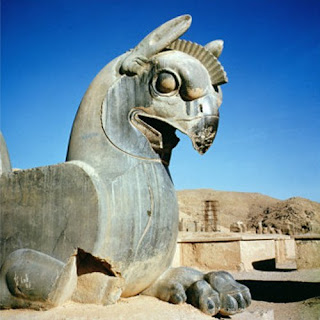A type of Lithography
Catherine, our print tutor, did a demonstration for us, of what she described as an old fashioned process, one that is not easily googled or researched. It is a form of Lithography which she herself learned in college, so lucky ol' us to be taught something unusual that gives interesting results.
The process uses Gum Arabic (a type of water based glue), and oil based paints.
The process uses Gum Arabic (a type of water based glue), and oil based paints.
Process:
Choose an image (in this case we were asked to choose one of our distorted self portraits) to use at A4 size. It needs to be black and white to work.
Here is mine.
First, soak some watercolour paper in water for approx 15 minutes.
Take some of the Gum Arabic, which has been diluted 50% with water, and puddle some
below the black and white photocopy that is to be printed, as well as above.
below the black and white photocopy that is to be printed, as well as above.
Smear it all over the surface with your fingers, be warned it is very delicate!! And it will very easily tear.
Next, squidge some of the ink onto the clean surface, & then roll the roller this way and that;
the idea is to get an even coat of paint on the roller.
Working from the center of the pic out to the edges, use the roller on the surface of the photocopy. Delicate!! As the paper is thin, (just ordinary photocopy paper), and very wet from the Gum Arabic, rolling on yet another product is asking a lot of the paper. The paint adheres to the black of the photocopy, so the aim is to make sure that the blacks and grays of the copy disappear and take up the colour of the paint, in this case yellow ochre. As you get near the edges, it's important to lift the roller up in to the air, as what tends to happen is that the paper starts to wrap itself around the roller. Keep the roller working in different directions, and as much in the centre as possible.
Here's the oil based paint that we used.
If you want less paint on the background, you can use your fingers to lift off some of the paint.
When you are feeling confident that you have covered your image evenly in as much paint as possible , lift it carefully onto some nearby sugar paper. Then place your soggy watercolour paper directly on top of it, as this is what you print onto. Lift this 'sandwich' of papers including the sugar paper(s) which are acting as supports, onto the base of the roller. Place more cheap paper on top, then the cardboard cover, then the felty mat, and finally wind the handle on the side to pass the whole shooting match through the roller.
In this photo, you can see the base plate with the cardboard lifted up above the layers of papers containing the image to be printed.
The moment of truth.... peeling off the water colour paper to see the image printed on it!
Finally, cleaning up...
A useful aid is a sort of metal bendy spatula which scrapes off a lot of the left over paint onto kitchen towel or equivalent, then finally plenty of elbow grease to scrub the rest off with paper.










Comments
Post a Comment